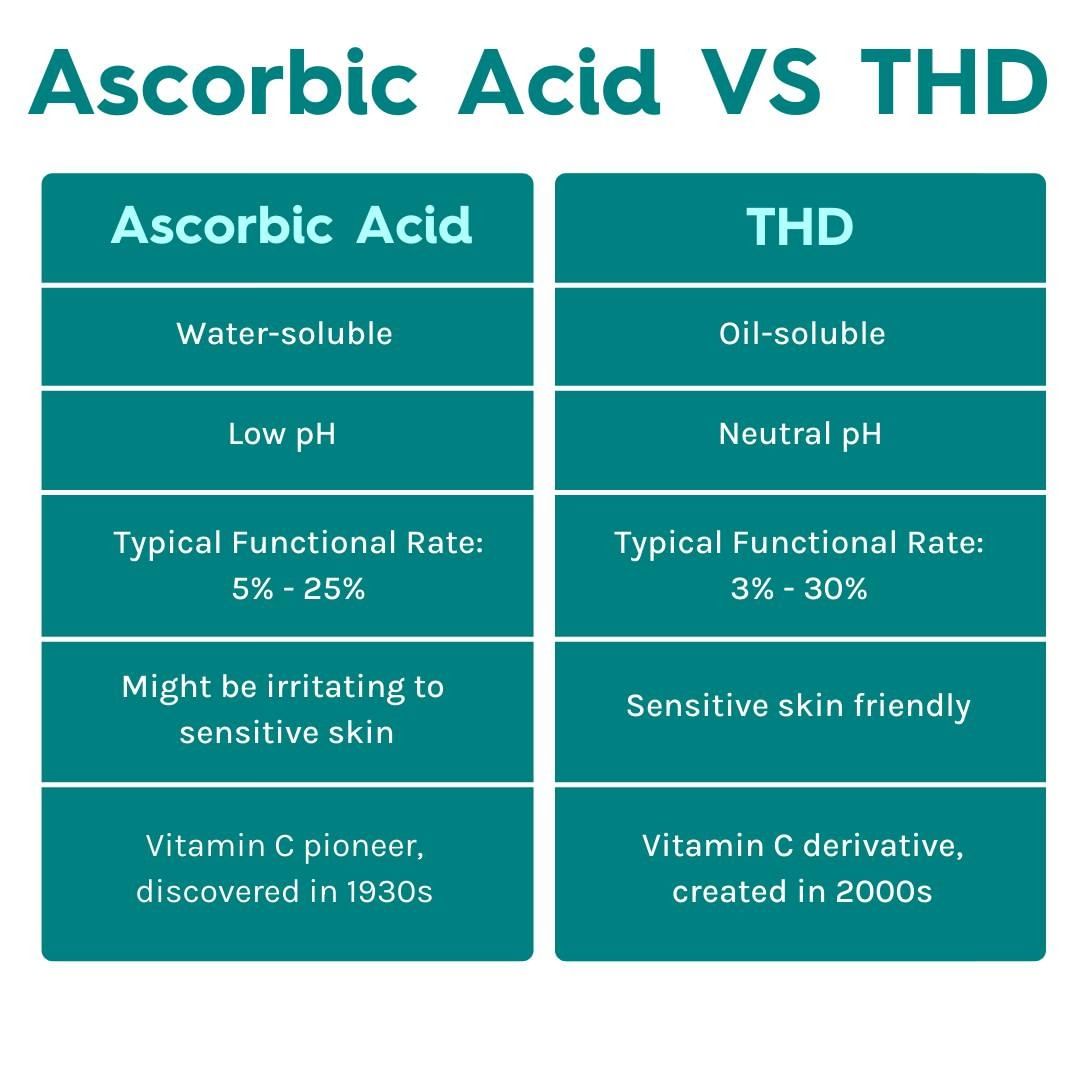Among all the other shelf-stable Vitamin C derivatives, THD is touted as a strong contender of Ascorbic Acid
On the prowl of looking into this claim, we read a few studies and summarized four with THD's benefits above for you. Now, do we agree that THD is a strong competitor with the MVP Ascorbic Acid?
Honestly, not really.
Tetrahexyldecyl Ascorbate (THD) is an organic compound formed from the reaction between Ascorbic Acid & pyridine reacting with hexyldecanoyl chloride. THD is often referred to as Ascorbyl Isopalmitate (AC-IP), stabilized, oil-soluble Vitamin C derivative, though both of them have a slightly different chemical structure.
In order for THD to work, it needs to be converted by the enzyme to ascorbic acid, within the dermis layer of the skin.

Comparing Ascorbic Acid and THD
While both of these are in the same vitamin C family, these two types of vitamin C has their own properties that made them different and appeal to different user.

Ascorbic Acid + THD
10 subjects with photo damaged skin were enrolled. One side of their face was treated with waterless polysilicon gel containing 10% ascorbic acid + 7% THD; another side of their face was treated with the same polysilicon gel but without the active.
After 12 weeks, compared to the placebo, the side treated with Ascorbic Acid + THD had
+ Lesser wrinkles; by improving of 18.6% (eye area), 8% (forehead), 13% (cheek) & 15% (around the mouth)
+ Lighter hyperpigmentation
+ Better hydration

- Pre-treatment: Photodamage, textural irregularity & wrinkles
- Post-treatment (12 weeks of Vitamin C): improvements in lines & texture
Retinol + THD
44 subjects were asked to apply a 30% THD moisturizer every morning and a 0.5% retinol teatment every other evening. After 12 weeks, compared to baseline scores, more than 75% of subjects showed improvement, as follows;

3% THD, Spirulina & Olive Extract
32 subjects were divided into 4 groups to study the efficacy of different actives in reducing pigmentation.
After 42 days, the researches discovered that 3% THD and 0.1% Spirulina sp. Improved basal layer brightness significantly and visibly under Reflectance Confocal Microscopy (RCM).

The Brightening Challenges
While some studies coupled THD with another actove to conclude it works, on its own, a few studies shows that THD protected cellular damage from UVA & UVB irradiation, and improved skin smoothness & roughness. But we expect vitamin C and it’s derivative like THD to brighten skin tone or lighten discoloration.
To tackle pigmentation THD has to breakthrough 2 barriers:-
-
Penetration into the dermis layer- great news. A study has pointed out that the oil soluble THD penetrates via the oil-loving stratum cornernum and hair follicles (via the associated infundibulum)
- Conversion into ascorbic acid- ultimately, the skin only recognized pure vitamin C. It’s theorized that THD gets converted to Vitamin C via enzymatic reaction of cytosolic esterase in the dermis layer of the skin. But the amount of conversion is not known. For example, if you apply a 20% THD serum, no study shows how much is truly converted and utilized to brighten the skin.
Our suggestions? THD, based on our humble literature readings, acts as a brilliant supporting ingredients. We await more studies to persuade us that it is capable of becoming a core star on it’s own.
If you wish to brighten skin tone/lighten pigmentation, and you are not struggling with sensitive skin, go directly with 10% - 20% ascorbic acid serums.
If you have sensitive skin and want a brighter skin tone, combine THD alongside other gentle brighteners like Alpha Arbutin, Tranexamic Acid, Niacinamide etc for better results.
Of course, always use brighteners with sunscreen!
Reference
1. Almeida, M. M. D., Lima, C. R. R. D. C., Quenca-Guillen, J. S., Moscardini Filho, E., Mercuri, L. P., Santoro, M. I. R. M., & Kedor-Hackmann, E. R. M. (2010). Stability evaluation of tocopheryl acetate and ascorbyl tetraisopalmitate in isolation and incorporated in cosmetic formulations using thermal analysis. Brazilian Journal of Pharmaceutical Sciences, 46(1), 129-134.
2. Campos, P. M. M., Gianeti, M. D., Camargo Jr, F. B., & Gaspar, L. R. (2012). Application of tetra-isopalmitoyl ascorbic acid in cosmetic formulations: Stability studies and in vivo efficacy. European journal of pharmaceutics and biopharmaceutics, 82(3), 580-586.
3. D'Angelo Costa, Gabriela Maria; Maia Campos, PatrÃcia Maria Berardo Gonçalves (2020). Efficacy of topical antioxidants in the skin hyperpigmentation control: A clinical study by reflectance confocal microscopy. Journal of Cosmetic Dermatology, (), jocd.13804–. doi:10.1111/jocd.13804
4. Fossa Shirata, M. M., & Maia Campos, P. M. B. G. (2021). Sunscreens and Cosmetic Formulations Containing Ascorbyl Tetraisopalmitate and Rice Peptides for the Improvement of Skin Photoaging: A Double‐blind, Randomized Placebo‐controlled Clinical Study. Photochemistry and Photobiology.
5. Goldberg, David J; Robinson, Deanne Mraz; Granger, Corinne (2019). Clinical evidence of the efficacy and safety of a new 3‐in‐1 anti‐aging topical night serum‐in‐oil containing melatonin, bakuchiol, and ascorbyl tetraisopalmitate: 103 females treated from 28 to 84 days. Journal of Cosmetic Dermatology, (), jocd.12896–. doi:10.1111/jocd.12896
6. Herndon, J. H. Jr. Jiang L. Kononov T. and Fox T. An open label clinical trial of a multi-ingredient anti-aging
moisturizer designed to improve the appearance of facial skin. Journal of Drugs in Dermatology.
2015;14(7):699-704.
7. Machado, N. C. F., dos Santos, L., Carvalho, B. G., Singh, P., Soto, C. T., Azoia, N. G., ... & Favero, P. P. (2016). Assessment of penetration of Ascorbyl Tetraisopalmitate into biological membranes by molecular dynamics. Computers in biology and medicine, 75, 151-159.
8. Richard E. Fitzpatrick; Elizabeth F. Rostan (2002). Double-Blind, Half-Face Study Comparing Topical Vitamin C and Vehicle for Rejuvenation of Photodamage. , 28(3), 231–236. doi:10.1046/j.1524-4725.2002.01129.x
9. Xiao, L., Kaneyasu, K., Saitoh, Y., Terashima, Y., Kowata, Y., & Miwa, N. (2009). Cytoprotective effects of the lipoidic‐liquiform pro‐vitamin C tetra‐isopalmitoyl‐ascorbate (VC‐IP) against ultraviolet‐A ray‐induced injuries in human skin cells together with collagen retention, MMP inhibition and p53 gene repression. Journal of cellular biochemistry, 106(4), 589-598


